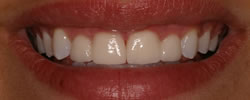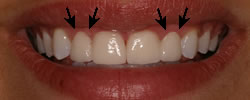Have you ever been told that you have a gummy smile? Are you self-conscious because your teeth seem to be so small in size because your gum sits lower on them? What about the opposite? What about if your teeth look too long because your gums sit too high on your teeth? Are you unhappy with the way they look? If you answered yes to any of these questions then gum contouring might be an option for you!
What can cause someone’s gums to either sit too low or too high on their teeth? Gums that sit too low on teeth can be the cause of genetics, health problems, or even by prescription medications. On the other hand, gums that sit too high on the teeth are often caused by recessed gums. This can be caused by things such as genes, brushing too hard, gum disease, hormonal changes, or inadequate dental care.
Gum contouring is often considered a cosmetic procedure, which means your dental insurance will most likely not cover it. However, if your gum contouring includes other procedures such as crown lengthening and tissue grafting, dental insurance might cover a percentage. In order to be financially prepared for whatever your personal services might entail, talk to the Insurance Coordinator at the office where you will be having your procedure done at. He/she will be able to guide you as to if your insurance will cover it, and if so, how much.
You might be asking yourself who performs your gum contouring. Your own family general dentist can perform a gum contouring procedure. However, if your dentist feels like it would be better for you to see a specialist, he or she would refer you to a periodontist (gum specialist). If you are feeling concerned, ask your dentist or specialist about their experience with gum contouring. They can go over their schooling, their years of experience, and set you at ease.
What should you be expecting when it comes to your gum contouring procedure? The procedure is performed in a typical dental office, no hospital or special office facility needed for this procedure. By now, your doctor will have already gone over the type of instruments he or she will use for your contouring – laser, scalpel, or radiosurgery. Your doctor will choose which of these is best for your specific gum contouring case. You will start your procedure with the doctor drawing a new line on your gums as to where the new gum line will be. This is where you can express any concerns or critiques about what your new gums will look like after the contouring. Once you are happy with the tracing, a local anesthetic is applied to the gums and the gum is removed. In some cases, some bone at the front of the tooth also has to be removed in order to get the best long term results.
Once your contouring is complete, you will want to take it easy for a few days as you and your gums recover. Your doctor will give you specific after procedure instructions, however, some common follow-up care includes:
- Take Tylenol or Advil to help with any pain or discomfort.
- Eat soft foods for the first few days such as yogurt, eggs, pasta, etc. Also during those first few days, avoid spicy food or anything with seeds that might irritate your gums.
- Follow your doctor’s instructions about when and how you should brush your teeth following the contouring.
- Contact your doctor if you experience swelling or increased bleeding.
If you or someone you know is unhappy with their smile and are thinking of gum contouring, contact Dr Fattahi and his staff for an appointment. They will happily answer any questions or concerns you might have regarding the procedure and check to see if you are a candidate.
Some people have teeth that look too “short” due to the relationship between their teeth and gums. This creates a “gummy” smile. A procedure called “gum contouring” is often used to remove excess gum tissue and expose more of the crown of the tooth. In fact, your gum line can be carefully sculpted to create just the right proportion between gum tissue and tooth surface — and the result is a better looking smile.
If the gum is uneven around a tooth, gum contouring can smooth and balance the way your tooth and gum look. The procedure produces a consistent, even gum line that is esthetically pleasing.
 |
 |
|
Before Gum Contouring
|
After Gum Contouring
|
Crown Lengthening is the same procedure applied for functional instead of (or in addition to) cosmetic reasons.



